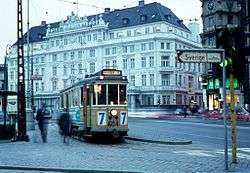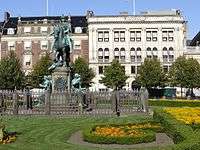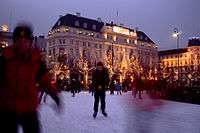Kongens Nytorv

Kongens Nytorv (lit. "The King's New Square") is a public square in Copenhagen, Denmark, centrally located at the end of the pedestrian street Strøget. The largest square of the city, it was laid out by Christian V in 1670 in connection with a major extension of the fortified city, and has an equestrian statue of him at its centre. The initiative moved the centre of the city from the medieval area around Gammeltorv, at that time a muddy medieval marketplace, to a cobbled new square with a garden complex, inspired by the Royal city planning seen in Paris from the early 17th century.[1]
Important buildings facing the square include the Royal Danish Theater from 1874, the Charlottenborg Palace from 1671 (now the Royal Danish Academy of Fine Arts), the Thott Palace from 1683 (now the French Embassy), the Hotel D'Angleterre and the Magasin du Nord department store.
History
New Copenhagen
In the beginning of the 17th century, the eastern city gate, Østerport, was located at the eastern ramparts of Copenhagen, Østervold, which ran along the western edge of the area later to become Kongens Nytorv with the eastern city gate located at the end of the street Østergade. Outside the gate, an undulating terrain extended towards the sea. As part of Christian IV's ambitious plans to strengthen Copenhagen as a regional centre, he wanted to double the area of the fortified city, he acquired 200 hectares of land outside Østerport in 1606. To protect the new city district, called New Copenhagen (Danish: Ny København) or Saint Anne's Town (Danish: Sankt Annæ By), he started construction of a redoubt, Saint Anne's Post (Danish: Sankt Annæ Skanse), at the site later to become Kastellet. In 1627 a customs house was added at the site. In the beginning of the 1640s the old Østervold was abandoned altogether in favour of the new ramperts further north, and the location of the King's new square, Kongens Nytorv, was decided in 1647 with the construction of the street Godtersgade in 1647. According to a masterplan from created by the fortification engineer Axel Urups, Kongens Nytorv was to be connected to the sea by a canal.[1]

At this time, under the reign of Frederik III, the site was a chaotic area, dominated by remains of the old ramparts and piles of garbage, almost made unpassable when wet weather transformed it into a muddy morass. Due to the topography and obstructed character of the premises, the site was popularly known as Hallandsåsen, a reference to the horst by the same name which had to be traversed when traveling from Scania and Halland.[1]
Lay out of the King's New Square
Shortly after Christian V was crowned in 1670, he decided to level and cobble the square. This decision was taken mainly for military reasons, its strategic location with almost the same distance to all points along the ramparts of the city making it well suited as a central alarm square. In the same time, the square was to serve as a place royale with inspiration from France. Land around the new square was distributed among interested wealthy citizens, including people from the new ranks. Buildings facing the square were required to be in at least two stories and meet certain standards.[2]

In 1688, a baroque garden complex with trees around a parterre and a gilded equestrian statue of Christian V in its centre, was inaugurated. In 1747 the entire square was rebuilt by Frederik V as a military drill and ceremony ground for the King's troops until 1908, where the square was re-shaped into its original design.
Features
Equestrian statue

The equestrian statue of Christian V was created by the French sculptor Abraham-César Lamoureux. Dating from 1688, it is the oldest equestrian statue in Scandinavia.[1] Originally made in gilded lead, it was recast in bronze 1939.
With direct inspiration from the equestrian statue of Louis XIII erected at the centre of Place des Vosges in Paris in 1639,[1] it depicts the king dressed like a Roman imperator with a Laurel wreathed helmet.
At the foot of the plinth, Lamoureux placed four allegorical statues. Facing Charlottenborg Palace stand figures of Minerva and Alexander the Great, representing prudence and fortitude, while the opposite side features statues of Herkules and Artemisia, personifications of strength and honour.
Even though Lamoureux depicted the horse in a trot-like gait, with inspiration from Marcus Aurelius' horse at the Capitoline Hill, the design caused severe problems due to the soft metal used for the casting. The construction therefore had to be strengthened, and Lamoureux introduced a figure of a naked man crouched underneath the horse's hoof, personifying envy but in the same time affording support for the horse's barrel as the weakest point of the statue. However, over the centuries the problems with the statue continued, particularly with the horse's front left leg, and finally Professor Einar Utzon-Frank from the Danish Academy of Fine Arts was commissioned to recast the statue in bronze. This happened from 1939 to 1942 and the new cast was inaugurated on May 22, 1946.
"Krinsen" Garden Complex
Krinsen is an old form of the Danish word Krans, meaning circle or wreath. It is an elliptical parterre surrounding the statue of Christian V. The ellipse was a favoured geometrical shape at the time, an obvious example bing the elliptical pattern in the paving around the Marcus Aurelius statue at Piazza del Campidoglio. Around the parterre, two rows of trees were planted. In 1711, the garden complex was remodelled, before it was given up in 1747 the garden was removed to make room for military drils, with some of the trees being dug altogether up, leaving only the equestrian statue. Some of the trees were dug up and reused for the establishment of the avenue Østre Allé. New rows of elm trees were planted around the statue in 1855-56, but by 1998 they were dying from Dutch elm disease and removed. In 2001, 80 lime trees were planted as part of a major refurbishment of the square.
.jpg)
Old kiosk
On the square stands an old kiosk and telephone stand from 1913. It is built in Baroque Revival style with a copper-clad roof and hand-carved ornamentation. It also used to offer the first public telephonic connection in Copenhagen from where it was possible to call every day except Sunday from 10 am to 8 pm.[2] Today it houses a small café with outdoor service.
Surrounding buildings
- Royal Danish Theatre, at No. 1, (built 1872–74)
- Charlottenborg Palace (built 1672-1683)
- Herdorff's House, at No. 3-5, (1780)
- Thott Palace, at No. 4, now housing the French Embassy (built 1683)
- 8 Kongens Nytorv, until 1979 the headquarters of A. P. Moller-Maersk Group, then until 2010 housing Jyllands-Posten's Copenhagen office (Hans Næs, 1908)
- Magasin du Nord, at No. 13, a leading department store (built 1893-94)
- Café a Porta, at No. 17, (built 1792)
- Lihmes Gård, at No. 18, (built 1787)
- Hviids Vinstue, at No. 19, the oldest tavern in Copenhagen (built 1767)
- 26 Kongens Nytorv, until 2003 the headquarters of Great Northern Telegraph Company (built 1893)
- Hotel D’Angleterre, at No. 34, (built 1874)
- Erichsens Palæ, headquarters of Danske Bank (built 1797-99)
Use

Outdoor exhibition space
The square is frequently used as an open-air exhibition venue, especially for photo exhibitions.
Ice skating rink
In winter a 2,200 m2 (23,681 sq ft) circular ice skating rink is constructed around Krinsen. Skating is free of charge and ice skate rental is available.
High school graduation celebrations
As an old tradition, graduating high school students from the Copenhagen area, when they graduate in June, come to Kongens Nytorv in buses, trucks or horse wagons to dance and run around Krinsen, throwing their graduation caps into the air, celebrating their graduation.
See also
| Wikimedia Commons has media related to Kongens Nytorv. |
References
- 1 2 3 4 5 "Kongens Nytorv". Selskabet for Københavns Historie. Retrieved 2009-08-25.
- 1 2 "Kongens Nytorv". Copenhagen Portal. Retrieved 2009-08-25.
Coordinates: 55°40′49″N 12°35′9″E / 55.68028°N 12.58583°E